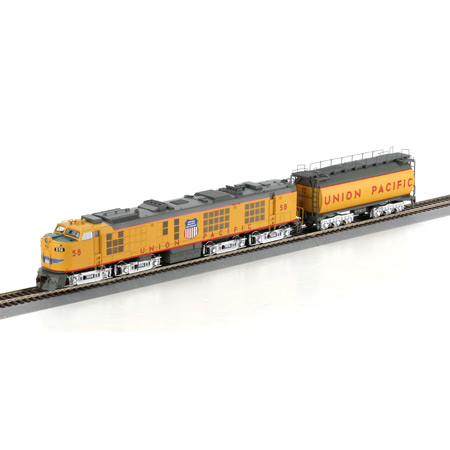Gas Turbine UP #58
Our Price $289.98
Item #: 88664
Road Name: Union Pacific
Road #58
Key Features
- Fully assembled and ready for your layout or display
- DCC ready wiring harness installed (8 or 9 pin decoder)
- Two speaker mounting points molded into underframe to accept speakers up to 1.20" in diameter
- Five pole skew wound armature motor
- 4 inboard axles are powered
- Celcon handrails
- Razor sharp painting and printing
- McHenry scale knuckle spring couplers installed
Overview
After World War II, GE began work on a locomotive using a gas turbine power plant specifically designed for locomotive usage. The gas turbine had an advantage in that it could burn Bunker “C” fuel oil. Bunker “C” is a thick, low-grade oil that is a left-over when crude oil is refined into higher quality products like gasoline and diesel fuel. Being a residual of the refining process, it was both very cheap and widely available. GE’s locomotive gas turbine was about 20 feet long and created 4,500 horsepower, three times as much as a contemporary diesel.
GE’s test-bed and demonstrator gas turbine locomotive was completed in November 1948. Numbered as UP 50, it spent twenty-one months testing on the UP, covering 105,732 miles of operation and moving 349 million gross ton-miles of freight. UP’s first gas-turbine, numbered 51, was received at the Omaha shops on January 28, 1952. It had a full car body and a single cab. It carried 7,200 gallons of fuel oil and 1,000 gallons of diesel fuel. In addition to the gas turbine, there was also a 250 horsepower diesel engine. The diesel was used to move the locomotive around yards, power the auxiliaries, and crank the turbine. The locomotive weighed 551,720 pounds and was just over 83 feet long and stood 15 feet six inches tall. It rode on two sets of span-bolster AAR Type B trucks with a wheel arraignment of B+B-B+B. The gear ratio was 74:18 that gave a maximum speed of 65 miles per hour and a starting tractive effort of 137,930 pounds. Like contemporary diesels, the gas turbines were equipped with dynamic brakes.
On the demonstrator and the first six locomotives, numbers 51 through 56, the air intake was through banks of screened openings in the car body sides. These intakes would change through out the life of the locomotives. Locomotives 51, 52, 56, 57, and 58 had stainless steel Farr grills added to protect the intakes. Number 53 was changed to a roof mounted air intake which proved successful. The other five of the original group were converted to the roof air intake in 1953 and the second group, numbers 57 through 60 were delivered with roof intakes.
In late 1955, UP extended the range of the gas turbines by adding a 22,000 gallon fuel tender. The original assignment for the gas turbines was Ogden, Utah to Green River, Wyoming. When the second order was delivered, the gas turbines began operating further east to Cheyenne, Wyoming. With the addition of the tenders, they could run between Ogden and Council Bluffs, Iowa without refueling and that remained their normal operating range for the rest of their careers. Seven of the ten standard turbines were retired in 1962. The remaining “baby” turbines were retired in 1963 and 1964.
The Athearn model brings the various versions of the turbine to life with side grill and roof intake variations, with each road number as prototypically accurate as possible.





